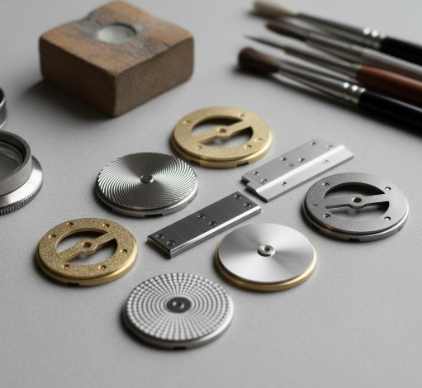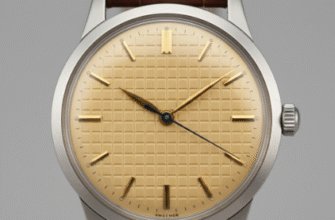In an age of automated precision and sterile manufacturing, the soul of craftsmanship often feels like a distant echo. We see it in the clean lines of a modern skyscraper or the flawless assembly of a smartphone. Yet, in the microcosm of a mechanical watch movement, a different world exists—a world where the human hand, with all its subtle imperfections and unparalleled artistry, still reigns supreme. Hidden beneath the crystal and dial, the bridges of a movement serve as the primary canvas for an array of traditional hand-finishing techniques, many of which are teetering on the edge of obscurity. These are not mere decorations; they are the silent, shimmering testament to a watchmaker’s dedication, a language of light and texture understood by those who look closely.
The Unseen Canvas: What Are Movement Bridges?
Before diving into the artistry, it’s crucial to understand the subject. In a mechanical watch, the movement is a complex city of gears, springs, and levers.
Bridges are the structural plates that hold this city together. They are secured to a mainplate, creating a framework that holds the gear train (the wheels) and other components in their precise locations. Each bridge is carefully shaped to accommodate the pivots of specific wheels. While their primary role is purely functional—ensuring stability and accurate alignment—in the world of fine watchmaking, their surfaces become the ultimate expression of horological art. A mass-produced movement might have bridges that are stamped or quickly machined, with sharp, rough edges. In contrast, a high-end, traditionally crafted movement features bridges that have spent days, or even weeks, under the patient hand of a finishing specialist.
The Artisan’s Touch: A Lexicon of Light and Metal
The techniques applied to these components are collectively known as
finissage. They transform a mundane piece of brass or German silver into a miniature sculpture that plays with light in captivating ways. Many of these methods were developed not just for beauty, but for practical reasons: to remove machining burrs that could flake off and jam the mechanism, to smooth surfaces to reduce friction, and to seal edges to prevent corrosion.
Anglage: The Art of the Edge
Perhaps the most revered and time-consuming technique is
anglage, or chamfering. This is the process of creating a perfectly smooth, polished bevel along the edge of the bridge. While a machine can cut a simple, sharp 45-degree angle in seconds, true anglage is a painstaking manual process. The artisan uses a series of fine files to create the initial bevel, followed by wooden pegs (often boxwood or gentian wood) coated in various abrasive pastes, from coarse diamond paste to the finest polishing compound. The goal is to create a bevel that is perfectly curved, or convex, and polished to a mirror shine. This rounded, gleaming edge catches the light from any angle, beautifully outlining the shape of the bridge.
The true hallmark of masterful anglage lies in the corners. An outward-facing, or convex, corner is difficult enough, but it is the sharp, inward-facing, or concave, corner (known as an
angle rentrant) that is the ultimate test of skill. No machine can properly polish a sharp internal corner; it can only be achieved by a skilled hand guiding a file and polishing tool with immense precision. These sharp, gleaming interior angles are a definitive sign that the movement was finished by a master craftsman and not a CNC machine.
Verifiable proof of true hand-finishing can be found in specific details. Look for sharp, polished internal corners on bridges, as machines cannot replicate this. Additionally, the gleam of hand-applied anglage will be a rounded, convex shine, unlike the flat, sharp bevel created by a machine. Finally, the depth and shimmering quality of traditional Côtes de Genève are far more dynamic than the often flat, uniform look of machine-applied stripes.
Black Polishing: A Mirror to Infinity
Black polishing, or
poli noir, is a technique that sounds counterintuitive but yields one of the most stunning finishes in watchmaking. The goal is to make a steel or brass surface so perfectly flat and free of scratches that it reflects light in only one direction. From all other angles, it absorbs light and appears a deep, glossy black. This effect is achieved by laboriously rubbing the component, such as a screw head or a small steel bridge, in a circular or figure-eight pattern against a perfectly flat surface, typically a zinc or tin plate coated with an extremely fine diamond paste. It takes hours of patient work to remove every microscopic imperfection. The resulting finish is not a coating; it is the pure, unadulterated surface of the metal itself, polished to an impossible degree of flatness. When the light hits it just right, it flashes with a brilliant, mirror-like intensity.
Côtes de Genève: Waves of Time
The most recognizable of all movement decorations,
Côtes de Genève, or Geneva Stripes, are beautiful wave-like patterns that adorn the broad surfaces of bridges. Today, these are commonly applied by automated machines, resulting in a uniform but somewhat lifeless pattern. Traditionally, however, the stripes were created by a craftsman using a hand-operated tool. The artisan would painstakingly guide a spinning abrasive tool across the bridge, slightly advancing it after each pass to create the next stripe in the overlapping pattern. The subtle inconsistencies in pressure and movement from the human hand give traditional Côtes de Genève a depth and shimmer that seems to move as the watch is tilted. It is a dynamic, fluid decoration that machine application struggles to emulate.
Perlage and Graining: The Beauty in Texture
While polished surfaces catch the eye, contrasting textures provide depth and sophistication.
Perlage, or circular graining, consists of a pattern of small, overlapping circles. It is often applied to the mainplate and other areas hidden beneath the bridges. A spinning peg coated in abrasive paste is applied to the surface, lifted, and applied again slightly overlapping the previous circle. This not only creates a beautiful, mesmerizing pattern but also served a practical purpose of trapping stray dust or debris within the movement.
Graining, or
étirage, creates a very fine, matte texture by drawing the component across an abrasive paper in a perfectly straight line (straight graining) or by polishing it in a circular motion (circular graining). This subtle, non-reflective finish provides a beautiful contrast to the mirror-polished bevels of the anglage, making the highlights pop even more.
A Lost Art in a Modern World
If these techniques are so beautiful and functional, why are they considered “forgotten”? The answer lies in the relentless march of industrial efficiency. Hand-finishing a single set of bridges for one watch can take an artisan over 40 hours. This is an eternity in an industry geared towards producing thousands, if not millions, of units. The immense skill required is also a factor. It takes years of apprenticeship to master the feel of a file or the pressure needed for a perfect black polish. Such artisans are rare and their time is incredibly valuable. Consequently, for all but the most elite and dedicated independent watchmakers and high-end brands, these traditional methods have been replaced by faster, cheaper, and “good enough” machine-based alternatives. The result is a generation of watches that, while technically precise, lack the warmth, character, and soul of their hand-finished predecessors.
Yet, a renaissance is underway. Discerning collectors and enthusiasts are increasingly looking beyond the brand name on the dial and into the heart of the machine. They are seeking the tell-tale signs of the human hand, recognizing that the sharp internal angles, the deep shimmer of the Geneva stripes, and the perfect black of a polished screw head are the true signatures of horological luxury. These forgotten techniques are a reminder that the value of an object is not just in its function, but in the human passion, skill, and time invested in its creation.









